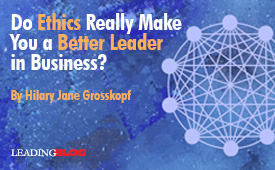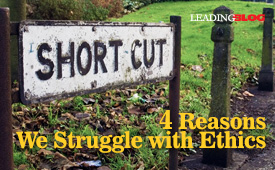 Leading Blog | Posts by Month |
 Leading Blog | Posts by Month |
02.28.14

LeadershipNow 140: February 2014 Compilation
See more on
Posted by Michael McKinney at 03:54 PM
02.26.14

The 7 Lenses of Ethical Leadership
O I believe that our current understanding of "ethical leadership" does not clearly describe the complexity and ethical implications of leader behaviors, and that there is an emerging clearer, bigger picture that will. A Continuum of Perspectives One of the reasons that it's so difficult to learn how to lead ethically is because we are not all using the same definition of our ultimate destination. To one leader, leading ethically means carefully protecting the environment. To another, it simply means responsible profitability. To a third, it means fair labor and responsible people management practices. To a fourth, it means serving the long-term greater good. I believe that the bigger picture of ethical leadership incorporates all of these many perspectives that seem to be at odds with each other. In our global society "ethical leadership" is actually a continuum of different perspectives. Understanding "ethical leadership" as a continuum of perspectives helps us understand our choices in a broader context. The way we define "leading ethically" needs to be broad enough, complex enough and multi-dimensional enough to help us talk about today's difficult choices intelligently.Talking about these differing perspectives as part of the whole, and not competing perspectives moves the conversation forward. A Multidimensional Framework In 7 Lenses, I describe a clear multidimensional framework for ethical leadership that incorporates seven different perspectives on what it means to lead ethically in a global society. This framework honors organizational complexity and guides leaders through the challenge of honoring multiple stakeholders when making decisions.
Only by considering all seven of these lenses do we get the full picture of our ethical leadership responsibility in a connected global society. Starting with the Profit Lens, each lens we add to our perspective gives us a new sense of clarity about what ethical responsibility means.Why is this ongoing learning journey so important for successful leadership? Besides responding to our moral responsibilities, proactive ethical leadership drives important business metrics and provides a competitive advantage. Forward-thinking leaders will use 7 Lenses as a learning guide on their journey to ethical leadership, and along the way, they will enjoy the many business benefits that result from bringing out the very best in their people and organizations.   
Posted by Michael McKinney at 08:24 PM
02.19.14

Culture Counts
CORPORATE AMERICA has had no shortage of heroes: Kellogg, Hewlett, Disney, Packard, Kroc, Watson, Ash and Iacocca. These leaders come to mind as examples of lions that have emblazoned their names as corporate giants. But far more important than heroic reputations are the values these captains of industry personified and instilled within their organizations.
The younger workforce presents challenges as well. This generation is far less enamored by traditional organizations and is more independent than any that came before. They can pose major challenges for today’s managers, especially if those managers are part of a different generation. New forms of stimulus and incentives should be created to appeal to these technologically savvy, bright, and environmentally conscious young minds. Presenting more stimulating assignments, frequent two-way dialogue, and company-supported affinity groups can help achieve this. The values of many former great leaders were forged by the experiences of the Great Depression, the wars in Afghanistan and Iraq, and humble beginnings. They understood the impact that a strong, adaptive corporate culture has on organizational performance, the true mark of leadership. They treated workers as their greatest asset, investing in and motivating them. They understood that the purpose of business was to serve the customer. They expected high standards for employee behavior which they themselves modeled and reinforced. Perhaps if today’s business leaders took a page from history, their companies would achieve the success created by the enlightened leadership of past corporate giants. And that would be a good thing. 
Posted by Michael McKinney at 07:32 PM
02.12.14

The Problem of More: Scaling Up Excellence
HOW DO YOU scale up excellence? How do you spread constructive beliefs and behavior from the few to the many? Bob Sutton and Huggy Rao tackle these questions in Scaling Up Excellence. What they found is that it simply isn’t a matter of just running up the numbers by replicating the same old magic again and again. In fact, they write, “Scaling well hinges on making the right trade-offs between mandating that new people and places become perfect clones of some original model versus encouraging local variation, experimentation, and customization. Something they refer to as the Catholic approach versus the Buddhist approach.Scaling up The process requires the mindset of a marathon. It’s like building a bridge as you walk on it. It requires faith and perseverance. Scaling is akin to running a long race where you don’t know the right path, often what seems like the right path turns out to be the wrong one, and you don’t know how long the race will last, where or how it will end, or where the finish line is located….[And yet] plenty of people and teams find ways to master this mess, take satisfaction in their daily accomplishments, and take pride in spreading constructive beliefs and behaviors far and wide. The book is centered on seven mantras of scaling up excellence. They serve as signals as to whether your scaling is going well or badly. Here are the mantras and how Sutton and Rao define them: Spread a Mindset, Not Just a Footprint
Engage All the Senses
Link Short-Term Realities to Long-Term Dreams
Accelerate Accountability
When scaling goes bad, three elements are usually present: Illusion, Impatience, and Incompetence. Decision makers think this is going to be far easier than the facts warrant; they are quick to rush the rollout thinking that when they are ready everyone is ready; and they frankly don’t know what they are doing. A related hallmark is that decision-makers don’t recognize when they are on the verge of subjecting victims (and themselves) to overwhelming mental load, distress, and turmoil. Scaling Requires Both Addition and Subtraction
Slow Down to Scale Faster—and Better—Down the Road
A few other thoughts to consider when considering a scaling an idea or initiative is to conduct a premortem. Ask participants to imagine that it is a year from now. What success or failure has occurred? Was it a good idea? Are we happy living in the world we’ve built? “Looking back from the future helps people bridge short-term and long-term thinking—a hallmark of successful scaling.” While excitement may be there in the beginning, it will soon wear off if steps are not taken to live it. “Although creating enthusiasm and spreading awareness about new beliefs, behaviors, and initiatives are useful first steps for mobilizing a mindset, they aren’t enough. People have to live it or it won’t stick.” Along the way, you need to continue to evaluate your beliefs and mindsets. “You should never stop asking whether the time is ripe to cast them aside.” As part of this approach, it is important to remember that “although more roles and processes are needed as organizations and projects expand, skilled leaders wield their power to eliminate needless friction and complexity—not burden employees with ‘rules, tools and fools’ that make it tougher to do their jobs and waste money and talent.” While scaling is often thought of in terms of growing a company, it is also about spreading an idea. Scaling Up Excellence is an excellent guide on both counts.

Posted by Michael McKinney at 10:48 PM
02.01.14

First Look: Leadership Books for February 2014Here's a look at some of the best leadership books to be released in February.




For bulk orders call 1-800-423-8273  Build your leadership library with these specials on over 120 titles. All titles are at least 40% off the list price and are available only in limited quantities. “Don't use words too big for the subject. Don't say infinitely when you mean very; otherwise you'll have no word left when you want to talk about something really infinite.” — C.S. Lewis
Posted by Michael McKinney at 07:08 AM
|
BUILD YOUR KNOWLEDGE


How to Do Your Start-Up Right STRAIGHT TALK FOR START-UPS 
Grow Your Leadership Skills NEW AND UPCOMING LEADERSHIP BOOKS 
Leadership Minute BITE-SIZE CONCEPTS YOU CAN CHEW ON 
Classic Leadership Books BOOKS TO READ BEFORE YOU LEAD |
| ||||||||||||||||||||||